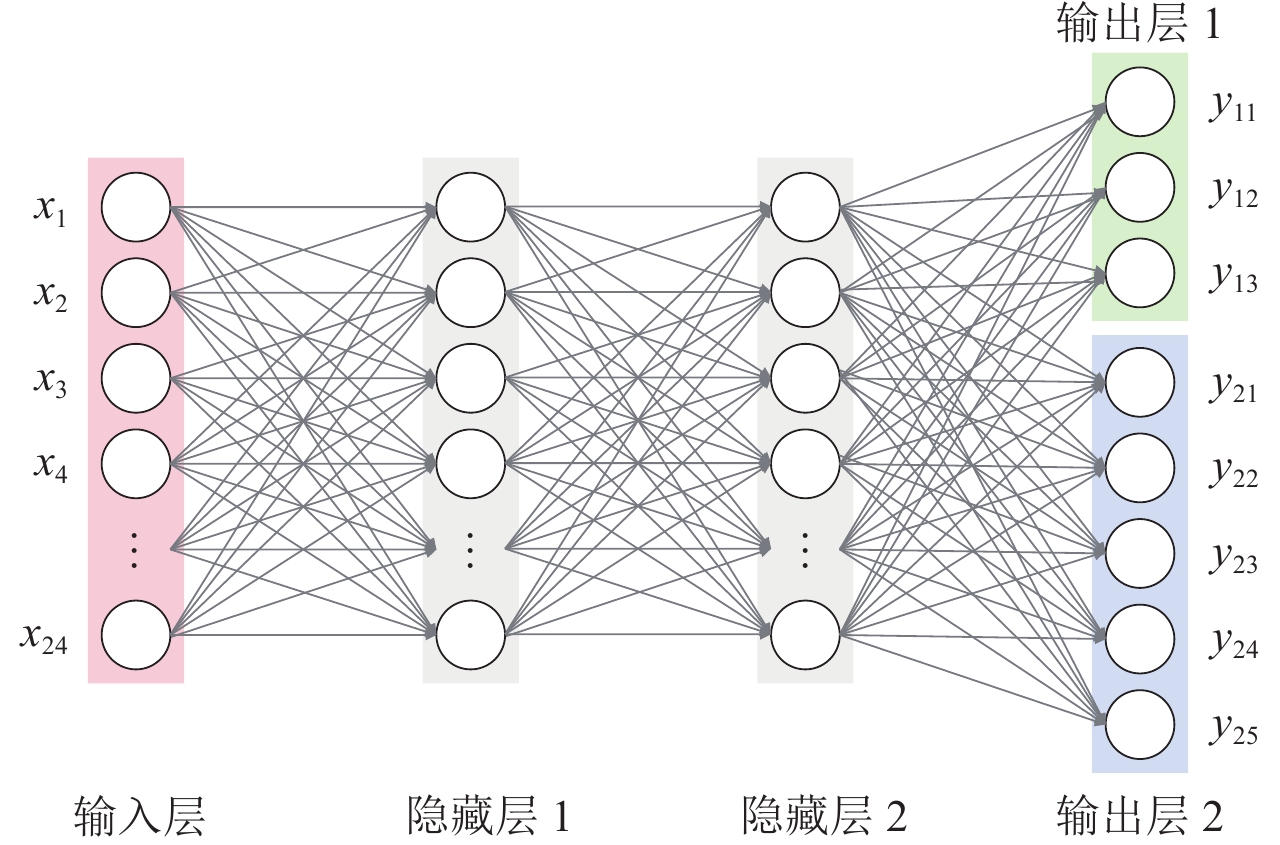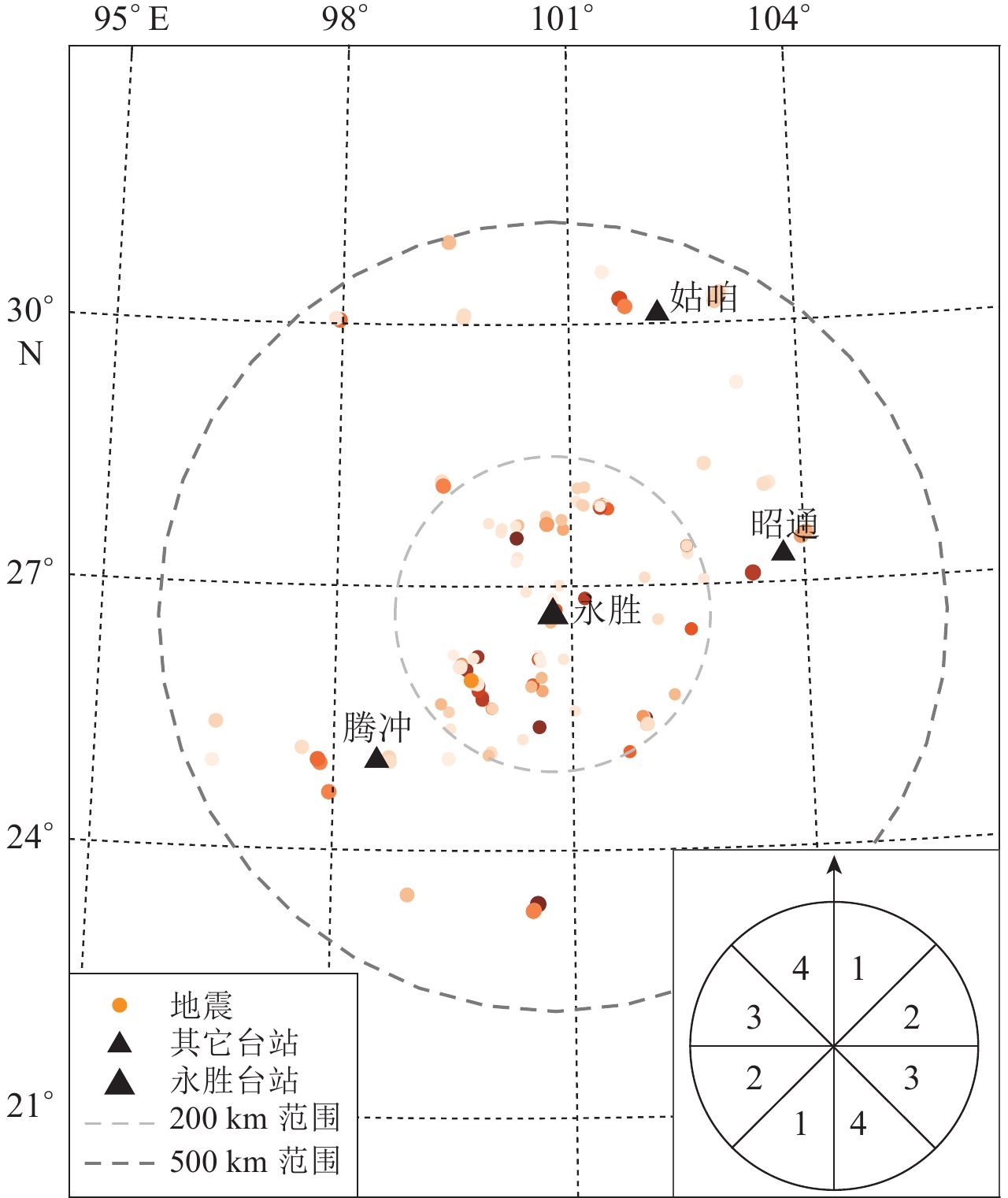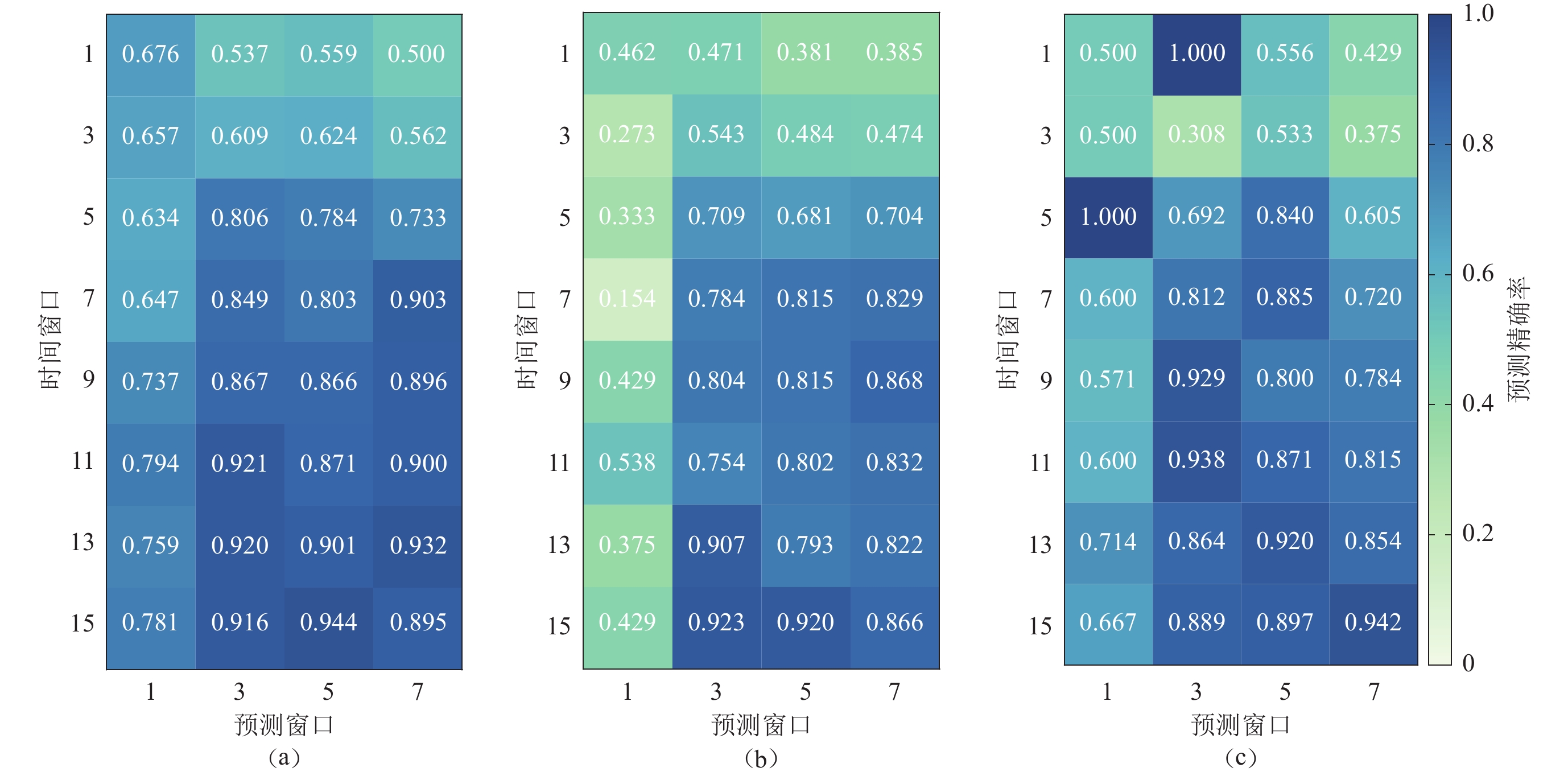Borehole strain data based seismicity prediction analysis using a neural network
-
摘要:
首先利用四分量钻孔应变数据独有的自洽特性,构建震前应变特征数据集;之后基于一维卷积神经网络框架,设计地震震级与方位的预测模型;然后通过混淆矩阵计算准确率、召回率以及F1分数,对模型预测结果进行评价与修正;最后对我国西南地区的永胜、昭通、姑咱及腾冲四个台站的钻孔应变特征分别进行训练与验证,并讨论了不同特征窗长对预测效果的影响。训练完成后的模型效果在测试集上均表现优异,四个台站对震级和方位预测的平均准确率分别可达85%和80%左右,说明四分量钻孔应变数据特征与地震的发生有着很强的相关性,通过卷积神经网络对地震前兆特征进行挖掘具有很大研究潜力,本文提出的预测策略也为未来短临地震的精确预测研究打下基础。
Abstract:With the development of seismological observational techniques, a number of case studies indicate that the seismogenic process of major earthquakes is often accompanied by deformation anomalies. Strain data serve as an indicator of crustal deformation, which reflects changes in subsurface stress and holds significant importance for seismology research. However, the research on the extraction of pre-earthquake anomalies from borehole strain data is currently limited to the stages of case analysis and small-sample statistical analysis. Thus, it is very meaningful to use a new technique of data mining to analyze the association between strain anomalies and earthquakes.
In order to dig out more strain information and correlation information between multiple strains, according to the scholars’ many analyses of the correlation between areal strains, shear strains and the self-consistent coefficients of the four-component strains, it is found that the borehole strain may reflect the preparatory process of earthquake nucleation. Therefore, this study calculates the Pearson correlation coefficients and self-consistent coefficients between these strains to finally constitute a 24-dimensional feature dataset. Subsequently, we divide earthquake events based on magnitude into three classes: no earthquake, earthquakes with 3.0≤MS<5.0, and earthquakes with MS≥5.0. Simultaneously, these earthquakes are also classified into five groups based on their orientation relative to the borehole strainmeter, forming an earthquake orientation dataset. Thereby, the labels for earthquake samples are generated according to these two classification criteria.
Next, the study employs a one-dimensional convolutional neural network (1D-CNN) framework to develop a short-term prediction model for the magnitude and location of earthquakes. The CNN can leverage the advantages of its convolutional layers’ parameter-sharing mechanism to effectively capture local features in the data. This 1D-CNN model consists of three parts: the input layer, hidden layers, and output layer. Strain feature samples from the dataset are used as inputs to the model, which outputs predicted values for earthquake magnitude and location labels. The hidden layer of the model is divided into two parts: the convolutional region and the fully connected region. We apply the cross-entropy loss function and the Adam optimizer for model compilation, and a learning rate decay strategy is used to dynamically adjust the learning rate. Parameter optimization is conducted using a random search algorithm. To evaluate this prediction model, we use a confusion matrix to calculate accuracy, recall, and F1 scores for examining the efficiencies for each class. Furthermore, the study adjusts the model’s prediction window size for earthquakes above magnitude 5.0 to balance the distribution of samples across different magnitude classes.
Finally, the borehole strain data from stations Guzan, Yongsheng, Zhaotong, and Tengchong in southwest China are respectively utilized for training and testing in this study. The results indicate that the pre-earthquake strain features from stations Yongsheng, Guzan, Zhaotong, and Tengchong exhibited a high level of accuracy up to 80% in predicting both magnitude and direction. Furthermore, the predictive results are independently validated for five typical major earthquakes in China. The findings demonstrate that the predicted magnitude and direction labels for these five earthquakes corresponded to the actual events, suggesting that the model successfully captures valuable pre-earthquake strain information and possesses predictive capabilities. Finally, we analyze the impact of the time window and prediction window sizes of input data on the model’s prediction accuracy across different magnitude classes. The results reveal that for all three magnitude classes, a longer time window leads to higher predictive accuracy of the model. Moreover, the results of major earthquakes are overall higher and more random than that of moderate earthquakes. It may reflect that the borehole strain has the short-term predictive capability for major earthquakes, and there are differences in pre-earthquake features among different major earthquakes.
The 1D-CNN models built in this study could effectively predict earthquake magnitude and approximate location using data from the respective stations. This demonstrates that the convolutional neural network architecture has the capability to extract meaningful pre-earthquake anomaly features from borehole strain data. This provides new insights and methods for research in earthquake precursory observations, laying a foundation for accurate earthquake predictions in the future. However, considering practical applicability, there are limitations to the methodology of this study. Future research will devise more robust networks to address sample imbalances by combining labels and achieve simultaneous predictions for the three seismic elements. Alternatively, a combination of multiple strain stations could be utilized, incorporating additional earthquake location information (such as epicentral distance and angles) to enhance directional prediction accuracy through partitioning high-resolution spatial grids. Moreover, experimental validations will be conducted on strain observation stations in seismically weak areas or other multi-seismic regions to establish a robust short-term earthquake prediction model suitable for strong seismic events.
-
-
表 1 24维应变数据特征
Table 1 Features of 24-dimensional strain data
序号 特征名称 物理含义 1 corr01_02 S1与S2间的皮尔逊相关系数 2 corr01_03 S1与S3间的皮尔逊相关系数 3 corr01_04 S1与S4间的皮尔逊相关系数 4 corr02_03 S2与S3间的皮尔逊相关系数 5 corr02_04 S2与S4间的皮尔逊相关系数 6 corr03_04 S3与S4间的皮尔逊相关系数 7—10 corr01_13—corr04_13 S1−S4与剪应变S1−S3间的皮尔逊相关系数 11—15 corr01_24—corr04_24 S1−S4与剪应变S2−S4间的皮尔逊相关系数 16—19 corr01+13—corr04+13 S1−S4与面应变S1+S3间的皮尔逊相关系数 20—23 corr01+24—corr04+24 S1−S4与面应变S2+S4间的皮尔逊相关系数 24 corr13+24 自洽系数 注:S1,S2,S3和S4为钻孔应变四分量观测值。 表 2 混淆矩阵
Table 2 Confusion matrix
实际正例 实际负例 预测正例 真正例(TP) 假正例(FP) 预测负例 假反例(FN) 真反例(TN) 表 3 永胜、昭通、姑咱和腾冲四个台站筛选的地震基本情况
Table 3 Basic information about the earthquake samples from the stations Yongsheng,Zhaotong,Guzan and Tengchong
台站 MS3.0—5.0地震数量 MS≥5.0地震数量 最大震级MS 最小距离/km 最大距离/km 永胜 99 47 7.0 5.96 491.86 昭通 138 31 7.0 31.09 497.47 腾冲 172 52 7.6 6.44 498.75 姑咱 287 36 7.0 13.89 431.65 表 4 永胜、昭通、姑咱和腾冲台震级预测结果表
Table 4 Magnitude prediction results for the stations Yongsheng,Zhaotong,Guzan and Tengchong
标签 精确率 召回率 准确率 F1值 样本数 标签 精确率 召回率 准确率 F1值 样本数 永胜台 0 0.903 0.823 0.861 147 昭通台 0 0.813 0.875 0.843 144 1 0.829 0.907 0.866 107 1 0.836 0.825 0.830 154 2 0.720 0.766 0.742 47 2 0.810 0.567 0.677 30 0.844 301(总) 0.823 328(总) 腾冲台 0 0.837 0.860 0.848 143 姑咱台 0 0.788 0.748 0.768 139 1 0.888 0.864 0.876 184 1 0.868 0.909 0.888 318 2 0.880 0.772 0.822 57 2 0.840 0.636 0.724 33 0.852 384(总) 0.845 490(总) 表 5 永胜、昭通、姑咱和腾冲台震源方位预测结果表
Table 5 Orientation prediction results for the stations Yongsheng,Zhaotong,Guzan and Tengchong
标签 精确率 召回率 准确率 F1值 样本数 标签 精确率 召回率 准确率 F1值 样本数 永胜台 0 0.879 0.837 0.857 147 昭通台 0 0.801 0.868 0.833 144 1 0.857 0.686 0.762 35 1 0.879 0.886 0.883 140 2 0.754 0.897 0.819 58 2 1.000 0.467 0.636 15 3 0.781 0.862 0.820 58 3 0.882 0.682 0.769 22 4 0.000 0.000 0.000 3 4 0.571 0.571 0.571 7 0.827 301(总) 0.838 328(总) 腾冲台 0 0.810 0.867 0.838 143 姑咱台 0 0.728 0.770 0.748 139 1 0.750 0.632 0.686 19 1 0.840 0.750 0.792 28 2 0.743 0.728 0.735 103 2 0.593 0.574 0.583 61 3 0.824 0.792 0.808 106 3 0.775 0.811 0.793 106 4 0.833 0.769 0.800 13 4 0.818 0.776 0.796 156 0.794 384(总) 0.755 490(总) 表 6 五次典型强震的实际预测效果
Table 6 Prediction results of five typical strong earthquakes
序号 发震日期 发震地点 MS 预测震级标签 实际震级标签 预测方位标签 实际方位标签 1 2 010−04−14 青海玉树 7.3 2 2 1 1 2 2 013−07−22 甘肃岷县 6.7 2 2 2 2 3 2 014−08−03 云南鲁甸 6.6 2 2 3 3 4 2 016−10−17 青海杂多 6.3 2 2 1 1 5 2 017−08−08 四川九寨沟 7.0 2 2 2 2 -
陈运泰. 2007. 地震预测:进展、困难与前景[J]. 地震地磁观测与研究,28(2):1–24. Chen Y T. 2007. Earthquake prediction:Progress,difficulties and prospects[J]. Seismological and Geomagnetic Observation and Research,28(2):1–24 (in Chinese).
陈运泰. 2008. 地震预测要知难而进[J]. 求是,15:58–60. Chen Y T. 2008. Predicting earthquakes requires perseverance and determination[J]. Qiushi,15:58–60 (in Chinese).
池顺良,刘琦,池毅,邓涛,廖成旺,阳光,张贵萍,陈洁. 2013. 2013年芦山MS7.0地震的震前及临震应变异常[J]. 地震学报,35(3):296–303. Chi S L,Liu Q,Chi Y,Deng T,Liao C W,Yang G,Zhang G P,Chen J. 2013. Borehole strain anomalies before the 20 April 2013 Lushan MS7.0 earthquake[J]. Acta Seismologica Sinica,35(3):296–303 (in Chinese).
池顺良,张晶,池毅. 2014. 汶川、鲁甸、康定地震前应变数据由自洽到失洽的转变与地震成核[J]. 国际地震动态,(12):3–13. Chi S L,Zhang J,Chi Y. 2014. Failure of self-consistent strain data before Wenchuan,Ludian and Kangding earthquakes and its relation with earthquake nucleation[J]. Recent Development in World Seismology,(12):3–13 (in Chinese).
高曙德. 2016. 深井地电观测技术在地震监测中的应用探讨[J]. 地球物理学进展,31(5):2078–2088. Gao S D. 2016. Discussion on the deep well geoelectric observation technique applied in earthquake monitoring[J]. Progress in Geophysics,31(5):2078–2088 (in Chinese).
高曙德. 2020. 四川九寨沟7.0级地震前震情跟踪概述及震后总结[J]. 地球物理学进展,35(4):1250–1260. Gao S D. 2020. Overview of tracking of Sichuan Jiuzhaigou MS7.0 earthquake in 2017 and its post earthquake precursor anomaly summary[J]. Progress in Geophysics,35(4):1250–1260 (in Chinese).
顾国华,王武星. 2020. 2016年日本本州东岸近海MS7.2地震前后的地壳运动[J]. 地震学报,42(2):196–204. Gu G H,Wang W X. 2020. Crustal movements of the eastern Honshu offshore MS7.2 earthquake in Japan in 2016[J]. Acta Seismologica Sinica,42(2):196–204 (in Chinese).
江在森,方颖,武艳强,王敏,杜方,平建军. 2009. 汶川8.0级地震前区域地壳运动与变形动态过程[J]. 地球物理学报,52(2):505–518. Jiang Z S,Fang Y,Wu Y Q,Wang M,Du F,Ping J J. 2009. The dynamic process of regional crustal movement and deformation before Wenchuan MS8.0 earthquake[J]. Chinese Journal of Geophysics,52(2):505–518 (in Chinese).
李进武,邱泽华. 2014. 钻孔应变仪观测的面应变潮汐因子初步分析[J]. 地球物理学进展,29(5):2013–2018. Li J W,Qiu Z H. 2014. Analysis on strain tidal factor observed borehole strainmeters[J]. Progress in Geophysics,29(5):2013–2018 (in Chinese).
廖晓峰,何康,张明东,何畅,魏强. 2018. 基于平滑伪魏格纳-维勒时频分析的地磁数据研究[J]. 地震,38(1):107–116. Liao X F,He K,Zhang M D,He C,Wei Q. 2018. Time-frequency analysis of geomagnetic data based on smooth pseudo-Wigner-Ville distribution[J]. Earthquake,38(1):107–116 (in Chinese).
刘琦,张晶,池顺良,闫伟. 2014. 2013年芦山MS7.0地震前后姑咱台四分量钻孔应变时频特征分析[J]. 地震学报,36(5):770–779. Liu Q,Zhang J,Chi S L,Yan W. 2014. Time-frequency characteristics of four-component borehole strain at Guzan station before and after 2013 Lushan MS7.0 earthquake[J]. Acta Seismologica Sinica,36(5):770–779 (in Chinese).
卢宏涛,张秦川. 2016. 深度卷积神经网络在计算机视觉中的应用研究综述[J]. 数据采集与处理,31(1):1–17. Lu H T,Zhang Q C. 2016. Applications of deep convolutional neural network in computer vision[J]. Journal of Data Acquisition and Processing,31(1):1–17 (in Chinese).
牛安福,张凌空,章静,闫伟,赵静,岳冲,苑争一. 2021. 汶川地震前远场形变异常及其与地震相关性研究[J]. 中国地震,37(1):15–21. Niu A F,Zhang L K,Zhang J,Yan W,Zhao J,Yue C,Yuan Z Y. 2021. Far field deformation anomaly and its correlation with earthquake before Wenchuan earthquake[J]. Earthquake Research in China,37(1):15–21 (in Chinese).
邱泽华,唐磊,周龙寿,阚宝祥. 2009. 四分量钻孔应变台网汶川地震前的观测应变变化[J]. 大地测量与地球动力学,29(1):1–5. Qiu Z H,Tang L,Zhou L S,Kan B X. 2009. Observed strain changes from 4-component borehole strainmeter network before 2008 Wenchuan earthquake[J]. Journal of Geodesy and Geodynamics,29(1):1–5 (in Chinese).
邱泽华,唐磊,张宝红,宋茉. 2012. 用小波-超限率分析提取宁陕台汶川地震体应变异常[J]. 地球物理学报,55(2):538–546. Qiu Z H,Tang L,Zhang B H,Song M. 2012. Extracting anomaly of the Wenchuan earthquake from the dilatometer recording at NSH by means of wavelet-overrun rate analysis[J]. Chinese Journal of Geophysics,55(2):538–546 (in Chinese).
邱泽华,杨光,唐磊,郭燕萍,张宝红. 2015. 芦山M7.0地震前姑咱台钻孔应变观测异常[J]. 大地测量与地球动力学,35(1):158–161. Qiu Z H,Yang G,Tang L,Guo Y P,Zhang B H. 2015. Abnormal strain changes prior to the M7.0 Lushan earthquake observed by a borehole strainmeter at Guzan[J]. Journal of Geodesy and Geodynamics,35(1):158–161 (in Chinese).
于紫凝. 2022. 钻孔应变观测数据的震前异常提取与评价方法研究[D]. 长春:吉林大学:16−17. Yu Z N. 2022. Pre-Earthquake Anomaly Extraction and Evaluation of Borehole Strain Observations[D]. Changchun:Jilin University:16−17 (in Chinese).
张敏,赵燕杰,文勇,孟鑫. 2014. 青海地区钻孔应变同震响应特征分析[J]. 高原地震,26(3):52–56. Zhang M,Zhao Y J,Wen Y,Meng X. 2014. Characteristics analysis on coseismic response of borehole strain in Qinghai area[J]. Plateau Earthquake Research,26(3):52–56 (in Chinese).
周飞燕,金林鹏,董军. 2017. 卷积神经网络研究综述[J]. 计算机学报,40(6):1229–1251. Zhou F Y,Jin L P,Dong J. 2017. Review of convolutional neural network[J]. Chinese Journal of Computers,40(6):1229–1251 (in Chinese).
张希,秦姗兰,贾鹏,李瑞莎. 2019. 2016年门源MS6.4地震孕育-发生的地形变异常特征[J]. 地震,39(4):27–38. Zhang X,Qin S L,Jia P,Li R S. 2019. Anomalies on characteristics of crustal deformation during the pregnant process of the Menyuan MS6.4 earthquake[J]. Earthquake,39(4):27–38 (in Chinese).
Chi C Q,Zhu K G,Yu Z N,Fan M X,Li K T,Sun H H. 2019. Detecting earthquake-related borehole strain data anomalies with variational mode decomposition and principal component analysis:A case study of the Wenchuan earthquake[J]. IEEE Access,7:157997–158006. doi: 10.1109/ACCESS.2019.2950011
De Santis A,Balasis G,Pavón-Carrasco F. J,Cianchini G,Mandea M. 2017. Potential earthquake precursory pattern from space:The 2015 Nepal event as seen by magnetic Swarm satellites[J]. Earth Planet Sci Lett,461:119–126. doi: 10.1016/j.jpgl.2016.12.037
Hirose H. 2011. Tilt records prior to the 2011 off the Pacific coast of Tohoku earthquake[J]. Earth Planet Space,63(7):655–658.
Ouyang X Y,Zong Q G,Bortnik J,Wang Y F,Chi P J,Zhou X Z,Yue C,Hao Y Q. 2018. Nightside ULF waves observed in the topside ionosphere by the DEMETER satellite[J]. J Geophys Res:Space Phys,123(9):7726–7739. doi: 10.1029/2018JA025248
Parrot M. 2017. Events linked to the lithosphere-atmosphere-ionosphere coupling observed by DEMETER[J]. USRI Radio Sci Bull, 2017 (360):75−79.
Pulinets S,Ouzounov D,Karelin A,Davidenko D. 2018. Lithosphere-atmosphere-ionosphere-magnetosphere coupling:A concept for pre-earthquake signals generation[C]//Pre-Earthquake Processes:A Multi-Disciplinary Approach to Earthquake Prediction Studies. Washington D.C.:AGU and John Wiley & Sons Inc:79−98.
Yu Z N,Hattori K,Zhu K G,Chi C Q,Fan M X,He X D. 2020. Detecting earthquake-related anomalies of a borehole strain network based on multi-channel singular spectrum analysis[J]. Entropy, 22 (10):1086.
Yu Z N,Zhu K G,Hattori K,Chi C Q,Fan M X,He X D. 2021a. Borehole strain observations based on a state-space model and ApNe analysis associated with the 2013 Lushan earthquake[J]. IEEE Access,9:12167–12179. doi: 10.1109/ACCESS.2021.3051614
Yu Z N,Hattori K,Zhu K G,Fan M X,Marchetti D,He X D,Chi C Q. 2021b. Evaluation of pre-earthquake anomalies of borehole strain network by using receiver operating characteristic curve[J]. Remote Sens, 13 (3):515.
Zhu K G,Yu Z N,Chi C Q,Fan M X,Li K Y. 2019. Negentropy anomaly analysis of the borehole strain associated with the MS8.0 Wenchuan earthquake[J]. Nonlinear Process Geophys,26(4):371–380. doi: 10.5194/npg-26-371-2019





 下载:
下载:





